The AMD Trinity Review (A10-4600M): A New Hope
by Jarred Walton on May 15, 2012 12:00 AM ESTAMD Trinity: Battery Life Also Improved
With all of the changes going into Trinity, one thing that hasn’t changed since Llano is the process technology. Trinity is once again coming on a 32nm process from GlobalFoundries. If we were talking about Intel, Trinity would represent a “Tock” on the roadmap—a new architecture on an existing process. We’ve looked at CPU and GPU performance, and this is a part that’s pretty much universally faster than its predecessor. Given the lengthier pipeline and Bulldozer-derived architecture, I admit that I was concerned Trinity might actually be a step back for battery life; it appears that my fears were unfounded, largely due to the improvements in Piledriver. As usual, we tested with all laptops set to 100 nits brightness in our idle, Internet, and H.264 playback tests. I also ran some additional tests which we’ll discuss in a moment. First, here are the standard battery life results:
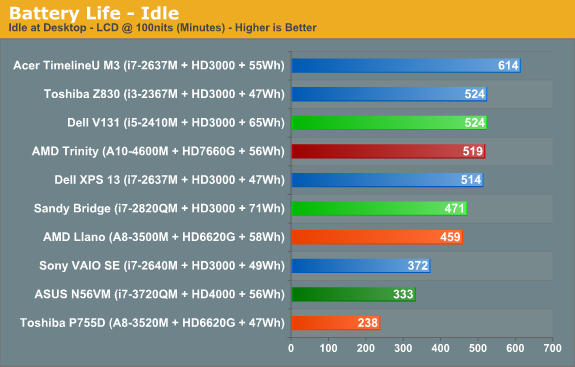
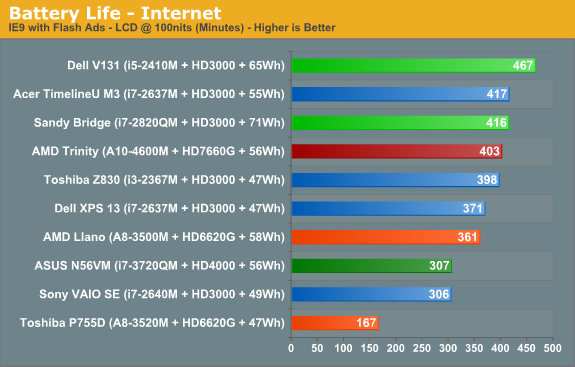
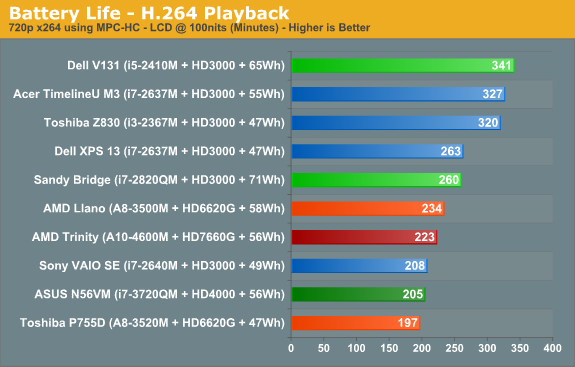
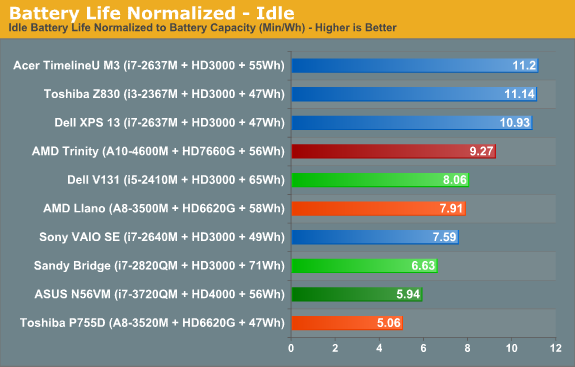

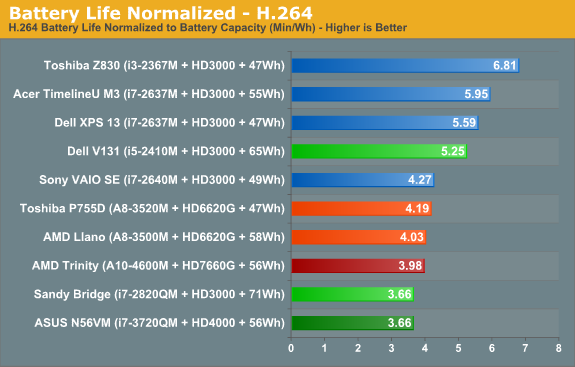
With a similar capacity battery to the original Llano laptop, and the same size 14” panel, Trinity comes out of the gates and posts two clear wins: idle battery life and Internet battery life are both up substantially relative to Llano. In fact, looking at the normalized charts, the only laptops that can consistently beat Trinity are found in Sandy Bridge ultrabooks—we won’t even bother discussing Atom or Brazos netbooks, as they’re competing in a completely different performance bracket. In something of a surprise, H.264 battery life doesn’t see the same benefit unfortunately, and it’s the one discipline where Llano still holds on to a slight lead over Trinity. Sandy Bridge meanwhile has always done very well in H.264 battery tests, and we see that with the Vostro V131 posting a normalized score that’s 30% better than Trinity and Llano. Of course, on the other end of the spectrum we have Ivy Bridge; we’ve only looked at one Ivy Bridge laptop so far, but if the pattern holds than Ivy Bridge will generally be a moderate step back in battery life relative to Sandy Bridge, giving AMD an even larger lead in this area.
We also performed a few other tests that we won’t present in graph form. One set of tests we alluded to earlier: the charts show Trinity with a Samsung 830 SSD, but we also ran tests with an Intel 520 SSD. Idle battery life dropped to 476 minutes (an 8% decrease), Internet battery life checked in at 371 minutes (down 8% again), and H.264 battery life stayed nearly the same at 217 minutes (down less than 3%). If battery life is one of your primary concerns, remember: all SSDs are not created equal!
Another test that we ran is simulated gaming; we looped the four graphics tests in 3DMark06 at 1366x768 until the battery ran out. We’ve run this same test on quite a few other laptops, and Llano initially looked to be far and away the best solution. Later, we discovered that when we tested Llano we were letting the GPU run in power saving mode—basically half the performance you’d get compared to being plugged in. We retested and measured 98 minutes, so the extra graphics performance comes with a heavy cost. We only tested Trinity (and Ivy Bridge and Sandy Bridge) using higher performance graphics settings, and this is one more area where it scores worse than Llano: Trinity managed just 77 minutes. That’s about the same as Ivy Bridge and Sandy Bridge (79 and 73 minutes, respectively), so if you’re after better gaming performance while running off the mains, you might need to keep looking.
Before getting too carried away with the above results, you still need to consider how important battery life is for your usage model. Some people travel a lot and like to go all day without plugging in; others will go from place to place and plug in whenever they’re not on the go. If you fall in the latter category, battery life isn’t usually a problem with any decent laptop, while those looking for all-day computing will definitely want as much mobility as possible. Ultimately, battery life is a factor of battery capacity as well as power optimizations done by the OEMs. We’ve seen battery life improve by as much as 50% when comparing two otherwise similar notebooks, but at least AMD’s reference platform for Trinity delivers a great starting point.
Temperatures and Acoustics
One other item we wanted to quickly touch on is system temperatures. We typically use HWMonitor and check temperatures of laptops under idle and load conditions. We did this with Trinity as well, but unfortunately the current version of HWMonitor doesn’t give us a lot of information. The only temperatures it reports are from the SSD and the HD 7660G graphics—there’s nothing about CPU core temperatures. That means we can’t provide much detail, other than to say that load temperature on the GPU topped out at 71C during extended testing, while the idle temperature was 39C. As usual, temperatures and noise levels go hand in hand, and the low 71C maximum GPU temperature matches up nicely with noise levels that never got above 37dB. It’s not the quietest laptop we’ve ever tested, and surface temperatures can get a little warm, but overall Trinity looks to be a good balance of performance and power requirements, which means quiet laptops are definitely possible.










271 Comments
View All Comments
Wierdo - Tuesday, May 15, 2012 - link
I'll start recommending an integrated Intel GPU once I feel more confident about their driver support, which is more important than performance.At least now the IGP in Ivy Bridge is a decent solution for basic gaming needs, but they really need to work on their drivers, no more of that "driver update five years after product is obsolete" bs.
Spunjji - Wednesday, May 16, 2012 - link
I agree, although even that seems to have improved somewhat; at least from the base standard of "what works to begin with". Here's hoping for further progress.medi01 - Wednesday, May 16, 2012 - link
Except there is one thing which isn't visible on charts: quality. Check how horrible Intel's AF is on toms Trinity review.fumigator - Tuesday, May 15, 2012 - link
"AMD still has better drivers than Intel, but it's more like 20% better "Unluckly I had an Ivy Bridge HD4000 notebook sitting for a week, and out of 29 games, only 60% were barely playable (performance), 15% crashed, and the rest run with strange artifacts but stable enough though.
While I don't worry alot about gaming in a laptop, the true fact is that intel is way behind AMD in this, and we are not talking about 3D render quality. Oh my, you have to take a look at that and you won't doubt it a second. AMD and Nvidia renders are better.
While I still hoped more from trinity, not sure to make a judgement until I grab one and put a decent super fast ram module on it and go testing.
JarredWalton - Tuesday, May 15, 2012 - link
Could you please provide a list of the games that were unplayable and those that crashed? I'd love to be able to confirm problems.frozentundra123456 - Tuesday, May 15, 2012 - link
The gpu is "several orders of magnitude" better than intel's best? You do realize that an order of magnitude is 10x right? So how many orders of magnitude better 2, 3, 4 (100x, 1000x, 10000x). Overstate much?In fact trinity is on average what, 20-30% better than HD4000? Hardly one order of magnitude much less multiple orders of magnitude.
Overall the chip is OK, but I was actually hoping for more improvement on the GPU side. Yes, it is improved, but not enough to really make a game go from unplayable to playable.
BSMonitor - Tuesday, May 15, 2012 - link
Most laptops from that time did not use Intel's IGP on the chipset. Most had AMD or nVidia dGPU's. And these new Trinity APU's probably compete pretty closely to that.RussianSensation - Tuesday, May 15, 2012 - link
Core 2 Duo came out in 2006 not 2004.Intel doesn't sell Core 2 Duo laptops anymore in mainstream segments. They sell IVB laptops.
Are you implying that C2D user will want to upgrade to Trinity?
Most users would be far better off getting an Intel laptop with low end Kepler GPU such as GT640 than this.
Lugaidster - Tuesday, May 15, 2012 - link
Assuming equal pricing sure. But there's no way an IVB with a low end Kepler will be near a trinity laptop in terms of pricing. Most likely it will be a few hundred dollars more, which depending on the target, can make a difference.Sure you can recommend that, but not everyone will see that as worth the extra couple of hundred dollars. Considering that aside from CPU performance, a trinity notebook is roughly equal to an IVB one, with price in their favour, they can sell lots of these.
JarredWalton - Tuesday, May 15, 2012 - link
I expect we'll see dual-core IVB with Kepler going for around $800-$850 at the low end of the scale. I also expect we'll see a lot of the early Trinity laptops with A10-4600M selling for closer to $700. Hopefully I'm wrong on the Trinity side, but they did the same thing with Llano. "It's new! Charge more for it!" Not AMD's fault at all, obviously, but still irritating.